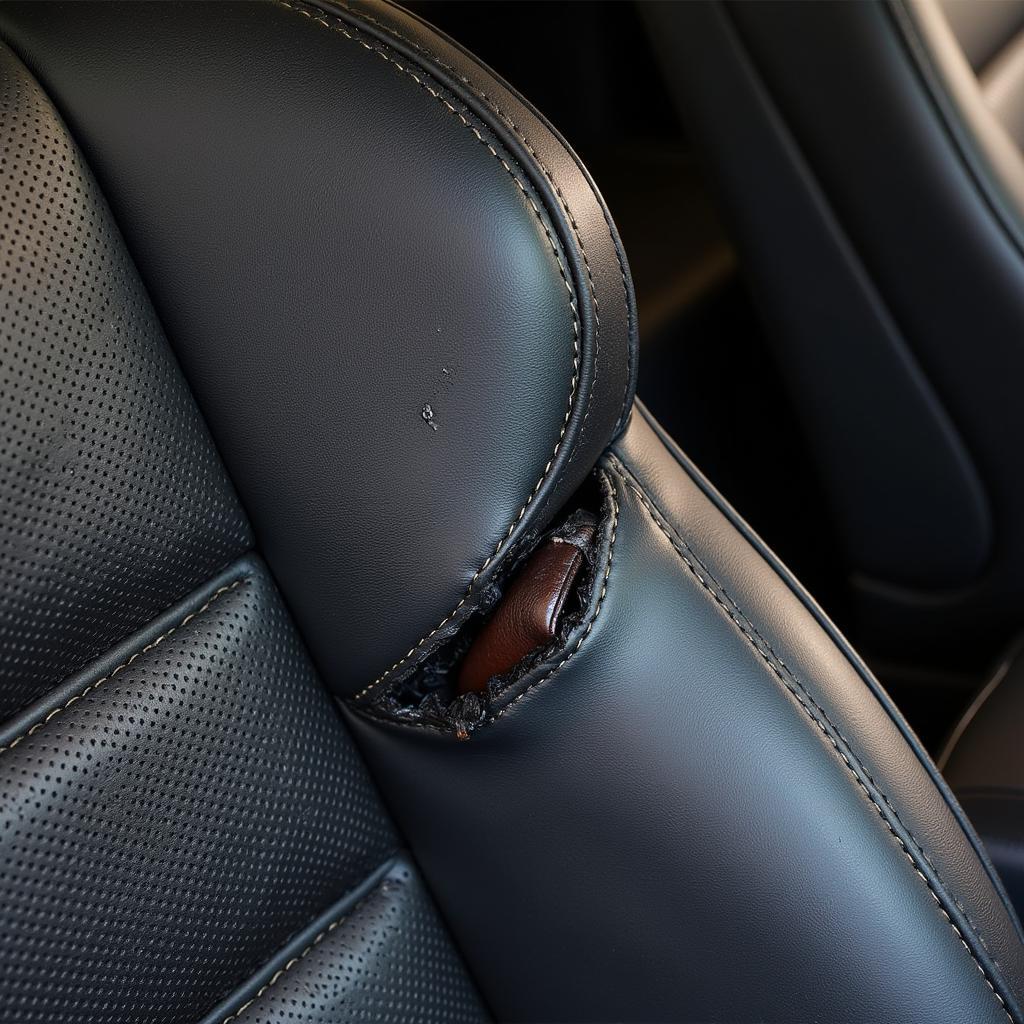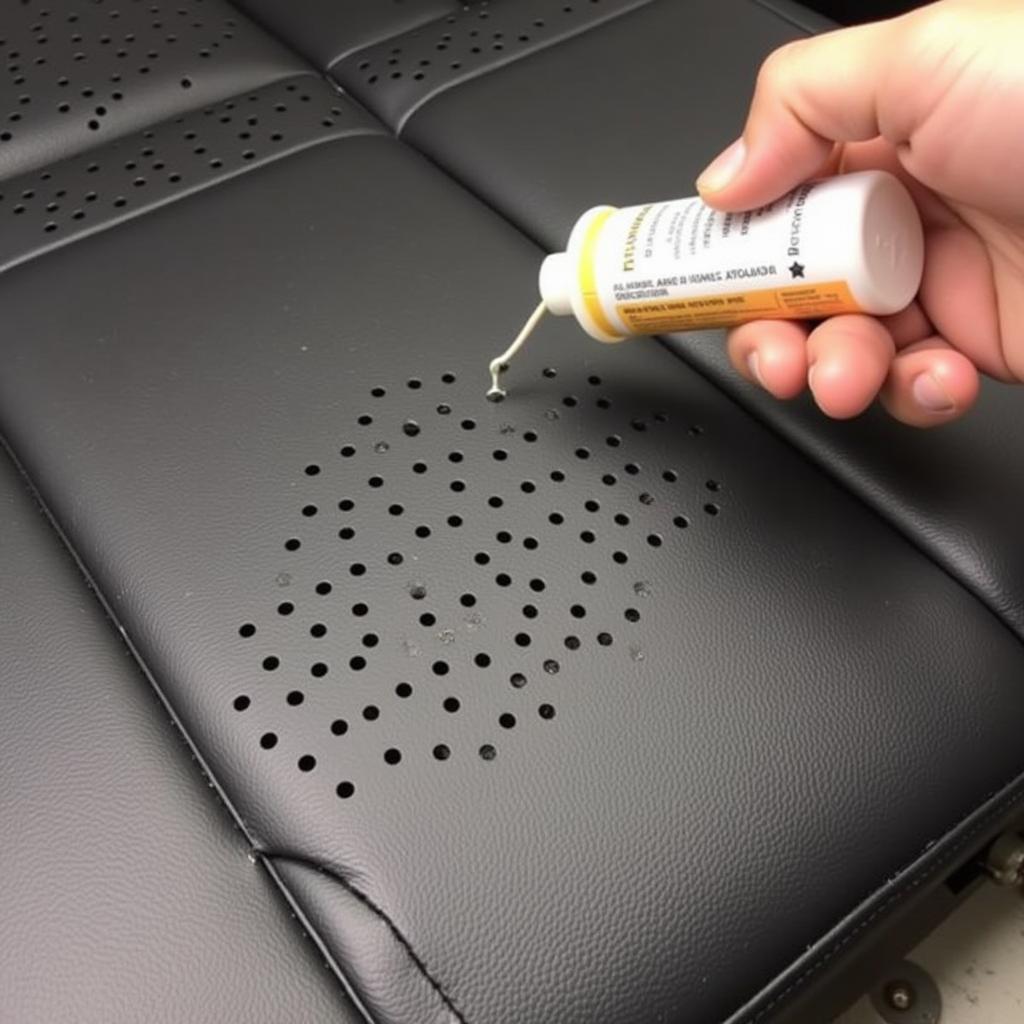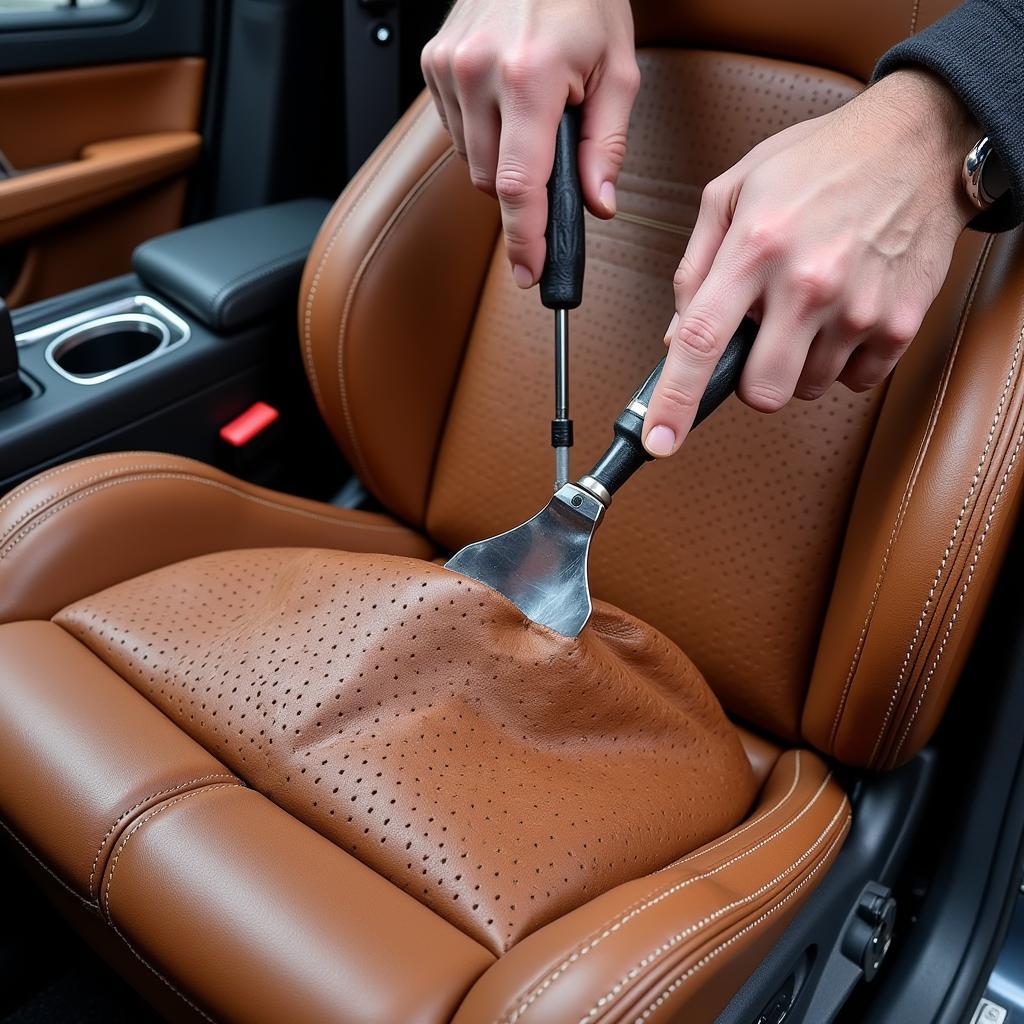Ripped perforated leather car seats can be a real eyesore, diminishing the overall aesthetic of your car’s interior. But fear not, fixing them is often more manageable than you might think. This guide will explore various methods to repair those pesky tears and restore your seats to their former glory. From DIY solutions to professional repairs, we’ll cover everything you need to know to tackle this common car interior issue.
Understanding the Challenge of Perforated Leather Repair
Perforated leather, while offering enhanced breathability and comfort, presents unique repair challenges. The tiny holes create vulnerabilities, making the leather more susceptible to tearing and requiring specialized repair techniques. Ignoring these tears can lead to further damage, so addressing the issue promptly is crucial.
Why Does Perforated Leather Rip?
Several factors can contribute to ripped perforated leather:
- Wear and tear: Regular use, especially friction from getting in and out of the car, can weaken the leather around the perforations.
- Sharp objects: Keys, pens, or other sharp items can easily snag and tear the delicate perforated leather.
- Sun damage: Prolonged exposure to sunlight can dry out and weaken the leather, making it prone to cracking and ripping.
- Pets: Pet claws can inflict significant damage on perforated leather seats.
 Ripped Perforated Leather Car Seat
Ripped Perforated Leather Car Seat
DIY Solutions for Ripped Perforated Leather Car Seats
For minor tears and scuffs, several DIY solutions can effectively address the issue:
-
Leather Repair Kit: These kits typically include a color-matched filler, adhesive, and grain paper to mimic the texture of the leather. Carefully clean the area, apply the filler, and use the grain paper to create a seamless repair.
-
Liquid Leather: Liquid leather is a flexible sealant that can fill small cracks and tears. Apply it in thin layers, allowing each layer to dry before applying the next.
-
Leather Patch: For larger tears, a leather patch can be a viable option. Choose a patch that closely matches the color and texture of your car’s leather. Apply adhesive to the back of the patch and carefully position it over the tear.
 Applying Liquid Leather Repair to Perforated Leather
Applying Liquid Leather Repair to Perforated Leather
How to Choose the Right Repair Method?
Choosing the right DIY method depends on the severity of the damage. For small cracks and surface abrasions, liquid leather or a repair kit is usually sufficient. Larger tears might require a leather patch or professional intervention.
When to Seek Professional Repair
While DIY solutions can be effective for minor repairs, some situations warrant professional help:
- Extensive damage: If the tear is large, complex, or involves multiple areas, a professional can provide a more durable and aesthetically pleasing repair.
- Airbag deployment: If the tear occurred during airbag deployment, it’s essential to have a professional inspect the seat’s structural integrity.
- Valuable or classic cars: For high-value vehicles, professional repair ensures the best possible outcome and preserves the car’s value.
What to Expect from a Professional Repair?
Professional repair services can offer various solutions, including:
- Patching: Using a piece of leather from a hidden area of the seat to create a seamless patch.
- Re-upholstery: Replacing the entire damaged section with new leather.
- Dyeing and refinishing: Restoring the color and finish of the repaired area to match the surrounding leather.
 Professional Leather Seat Repair
Professional Leather Seat Repair
Preventing Future Damage to Perforated Leather Seats
Regular maintenance and preventive measures can help protect your perforated leather seats from future damage:
- Regular cleaning: Use a leather cleaner and conditioner to keep the leather supple and prevent cracking.
- UV protection: Park your car in the shade or use a sunshade to protect the leather from sun damage.
- Seat covers: Consider using seat covers to protect the leather from wear and tear, especially if you have pets or frequently carry passengers.
Conclusion
Fixing ripped perforated leather car seats, whether through DIY methods or professional services, is essential for maintaining the interior aesthetics and value of your vehicle. By understanding the causes of damage and choosing the appropriate repair method, you can restore your seats to their former glory and prevent further issues down the road. For expert advice and assistance with your car’s interior repairs, connect with AutoTipPro at +1 (641) 206-8880 or visit our office at 500 N St Mary’s St, San Antonio, TX 78205, United States. We’re here to help keep your car looking its best.
“Proper leather care is an investment that pays off in the long run,” says Johnathan Davis, Lead Automotive Upholsterer at Davis Auto Interiors. “Regular cleaning and conditioning can significantly extend the life of your leather seats.”
“Don’t underestimate the damage that sun exposure can cause to leather,” adds Maria Sanchez, Automotive Detailing Specialist at Pristine Auto Detailing. “A simple sunshade can make a world of difference in preventing premature cracking and fading.”
FAQ
-
Can I use super glue to repair ripped perforated leather? While super glue might seem like a quick fix, it’s not recommended for leather repair as it can create a stiff, inflexible bond that may crack over time.
-
How much does professional leather seat repair cost? The cost varies depending on the extent of the damage and the type of repair needed. Minor repairs might cost a few hundred dollars, while more extensive repairs or reupholstery can cost significantly more.
-
How long does liquid leather take to dry? Drying time varies depending on the product and the ambient temperature, but it typically takes several hours to fully cure.
-
Can I repair leather seats with a heat gun? A heat gun can be used cautiously by experienced professionals for certain leather repairs, but it’s not recommended for DIY use as it can easily damage the leather.
-
What is the best way to clean perforated leather car seats? Use a dedicated leather cleaner and conditioner designed for perforated leather to avoid clogging the perforations.
-
How can I protect my leather car seats from pet damage? Pet seat covers or hammocks are the most effective way to protect your leather seats from scratches and tears caused by pets.
-
How often should I condition my leather car seats? Conditioning your leather seats every few months can help keep the leather supple and prevent cracking.




Leave a Reply